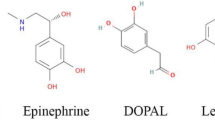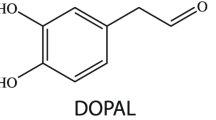Abstract
Aggregation of the protein alpha-synuclein has been identified in the pathogenesis of Parkinson’s disease and is initiated by the folding of the protein monomer into an amyloid form of insoluble fibrils. The neurotransmitters dopamine and norepinephrine have been shown to both inhibit the formation of these fibrils and disaggregate existing fibrils, yielding the more toxic oligomeric form of α-synuclein. This study characterizes the stable oligomers formed through the aggregation and disaggregation processes in the presence of these catecholamines, and suggests differences in oligomer formation depending on the extent of oxidation of the neurotransmitter at the time of oligomerization. Unique oligomers are also stabilized, likely formed from the aggregation of monomeric α-synuclein and a proteolytic fragment of α-synuclein; however, proteolytic fragments do not form as readily in the presence of these neurotransmitters. These findings suggest novel pathways for the formation of α-synuclein oligomers in the presence of neurotransmitters, particularly oxidized forms.







Similar content being viewed by others
References
Brookmeyer R, Gray S, Kawas C (1998) Projections of Alzheimer’s disease in the United States and the public health impact of delaying disease onset. Am J Public Health 88:1337–1342
Samii A, Nutt J, Ransom B (2004) Parkinson’s disease. Lancet 363:1783–1793
Ernst R, Hay J, Fenn C, Tinklenberg J, Yesavage J (1997) Cognitive function and the costs of Alzheimer disease: an exploratory study. Arch Neurol 54:687–693
Rosello A, Warnes G, Meier U (2012) Cell death pathways and autophagy in the central nervous system and its involvement in neurodegeneration, immunity and central nervous system infection: to die or not to die: that is the question. Clin Exp Immunol 168:52–57
Skovronsky D, Lee V (2006) Neurodegenerative diseases: new concepts of pathogenesis and their therapeutic implications. Annu Rev Pathol Mech Dis 1:151–170
Ramirez-Alvarado M, Merkel J, Regan L (2000) A systematic exploration of the influence of the protein stability on amyloid fibril formation in vitro. PNAS 97:8979–8984
Pollanen M, Dickson DW, Bergeron C (1993) Pathology and biology of the Lewy body. J Neuropathol Exp Neurol 52:183–191
Forno LS (1996) Neuropathology of Parkinson’s disease. J Neuropathol Exp Neurol 55:259–272
Takahashi H, Wakabayashi K (2001) The cellular pathology of Parkinson’s disease. Neuropathology 21:315–322
Li J, Zhu M, Manning-Bog A, Di Monte DA, Fink A (2004) Dopamine and L-dopa disaggregate amyloid fibrils: implications for Parkinson’s and Alzheimer’s disease. FASEB J 18:962–964
Conway K, Rochet J-C, Bieganski RM, Lansbury PT (2001) Kinetic stabilization of the alpha-synuclein protofibril by a dopamine-alpha-synuclein adduct. Science 294:1346–1349
Goldberg MS, Lansbury PT (2000) Is there a cause-and-effect relationship between alpha synuclein fibrillization and Parkinson’s disease? Nat Cell Biol 2:E115–E119
Caughey B, Lansbury PT (2003) Protofibrils, pores, fibrils, neurodegeneration: separating the responsible protein aggregates from the innocent bystanders. Annu Rev Neurosci 26:267–298
Winner B, Jappelli R, Maji S, Desplates P, Boyer L, Aigner S (2011) In vivo demonstration that α-synuclein oligomers are toxic. PNAS 108:4194–4199
Volles MJ, Lansbury PTJ (2003) Zeroing in on the pathogenic form of alpha-synuclein and its mechanism of neurotoxicity in Parkinson’s disease. Biochemistry 42(26):7871–7878
Fink AL (2006) The aggregation and fibrillation of α-synuclein. Acc Chem Res 39:628–634
Bisaglia M, Tosatto L, Munari F, Tessari I, de Laureto PP, Mammi S, Bubacco L (2010) Dopamine quinones interact with alpha-synuclein to form unstructured adducts. Biochem Biophys Res Commun 394:424–428
Rochet J-C, Outeiro TF, Conway KA, Ding TT, Volles MJ, Lashuel HA, Bieganski RM, Lindquist SL, Lansbury PT Jr (2004) Interactions among alpha-synuclein, dopamine, and biomembranes. J Mol Neurosci 23:23–33
Conway K, Lee S-J, Rochet J-C, Ding TT, Williamson RE, Lansbury PT (2000) Acceleration of oligomerization, not fibrillization, is a shared property of both a-synuclein mutations linked to early-onset Parkinson’s disease: implications for pathogenesis and therapy. PNAS 97:571–576
Polymeropoulos MH, Lavedan C, Leroy E, Ide SE, Dehejia A, Dutra A, Pike B, Root H, Rubenstein J, Boyer R, Stenroos ES, Chandrasekharappa S, Athanassiadou A, Papapetropoulos T, Johnson WG, Lazzarini AM, Duvoisin RC, Di Iorio G, Golbe LI, Nussbaum RL (1997) Mutation in the alpha-synuclein gene identified in families with Parkinson’s disease. Science 276:2045–2047
Kruger R, Kuhn W, Muller T, Woitalla D, Graeber M, Kosel S, Przuntek H, Epplen JT, Schols L, Riess O (1998) Ala30Pro mutation in the gene encoding alpha-synuclein in Parkinson’s disease. Nat Genet 18:106–108
Vlad C, Lindner K, Karreman C, Schildknecht S, Leist M, Tomczyk N, Rontree J, Langridge J, Danzer K, Ciossek T, Petre A, Gross ML, Hengerer B, Przybylski M (2011) Autoproteolytic fragments are intermediates in the oligomerization-aggregation of Parkinson’s disease protein alpha-synuclein as revealed by ion mobility mass spectrometry. ChemBioChem 12:2740–2744
Naiki H, Higuchi K, Hosokawa M, Takeda T (1989) Fluorometric determination of amyloid fibrils in vitro using the fluorescent dye, thioflavine T. Anal Biochem 177:244–249
Schultz W (2007) Multiple dopamine functions at different time courses. Annu Rev Neurosci 30:259–288
Bisaglia M, Mammi S, Bubacco L (2007) Kinetic and structural analysis of the early oxidation products of dopamine: analysis of the interactions with alpha-synuclein. J Biol Chem 282:15597–15605
Leong SL, Pham CL, Galatis D, Fodero-Tavoletti MT, Perez K, Hill AF (2009) Formation of dopamine-mediated α-synuclein-soluble oligomers requires methionine oxidation. Free Radic Biol Med 46:1328–1337
Leong SL, Cappai R, Barnham KJ, Pham CLL (2009) Modulation of alpha-synuclein aggregation by dopamine: a review. Neurochem Res 34:1838–1846
Wood SJ, Wypych J, Steavenson S, Louis JC, Citron M, Biere AL (1999) Alpha-synuclein fibrillogenesis is nucleation-dependent. Implications for the pathogenesis of Parkinson’s disease. J Biol Chem 274:19509–19512
Norris EH, Giasson BI, Hodara R, Xu S, Trojanowski JQ, Ischiropoulos H, Lee VM (2005) Reversible inhibition of alpha-synuclein fibrillization by dopaminochrome-mediated conformational alterations. J Biol Chem 280:21212–21219
Pham AN, Waite TD (2014) Cu(II)-catalyzed oxidation of dopamine in aqueous solutions: mechanism and kinetics. J Inorg Biochem 137:74–84
Pham CLL, Leong SL, Ali FE, Kenche VB, Hill AF, Gras SL, Barnham KJ, Cappai R (2009) Dopamine and the dopamine oxidation product 5,6-dihydroxylindole promote distinct on-pathway and off-pathway aggregation of alpha-synuclein in a pH-dependent manner. J Mol Biol 387:771–785
Manini P, Panzella L, Napolitano A, d’Ischia M (2007) Oxidation chemistry of norepinephrine: partitioning of the o-quinone between competing cyclization and chain breakdown pathways and their roles in melanin formation. Chem Res Toxicol 20:1549–1555
Whitehead RE, Ferrer JV, Javitch JA, Justice JB (2001) Reaction of oxidized dopamine with endogenous cysteine residues in the human dopamine transporter. J Neurochem 76:1242–1251
Kato T, Ito S, Fujita K (1986) Tyrosinase-eatalyzed binding of 3,4-dihydroxyphenylalanine with proteins through the sulfhydryl group. Biochim Biophys Acta 881:415–421
Graham DG (1978) Oxidative pathways for catecholamines in the genesis of neuromelanin and cytotoxic quinones. Mol Pharmacol 14:633–643
Belluzzi E, Bisaglia M, Lazzarini E, Tabares LC, Beltramini M, Bubacco L (2012) Human SOD2 modification by dopamine quinones affects enzymatic activity by promoting its aggregation: possible implications for Parkinson’s disease. PLoS ONE 7:1–9
Mazzulli JR, Armakola M, Dumoulin M, Parastatidis I, Ischiropoulos H (2007) Cellular oliogomerization of alpha-synuclein is determined by the interaction of oxidized catechols with a C-terminal sequence. J Biol Chem 282:31621–31630
Jimenez M, Garcia-Canovas F, Garcia-Carmona F, Lozano JA, Iborra JL (1984) Kinetic study and intermediates identification of noradrenaline oxidation by tyrosinase. Biochem Pharmacol 33:3689–3697
Bindoli A, Rigobello MP, Deeble DJ (1992) Biochemical and toxicological properties of the oxidation products of catecholamines. Free Radic Biol Med 13:391–405
Li H-T, Lin D-H, Luo X-Y, Zhang F, Ji L-N, Du H-N, Song G-Q, Hu J, Zhou J-W, Hu H-Y (2005) Inhibition of alpha-synuclein fibrillization by dopamine analogs via reaction with the amino groups of alpha-synuclein. FEBS J 272:3661–3672
Acknowledgments
Research supported in part by NSF grant CHE-1229562, Elon Chemistry Department, Elon College Fellows, Elon University Undergraduate Research Program, and the Elon Lumen Prize.
Author information
Authors and Affiliations
Corresponding author
Rights and permissions
About this article
Cite this article
Fischer, A.F., Matera, K.M. Stabilization of Alpha-Synuclein Oligomers In Vitro by the Neurotransmitters, Dopamine and Norepinephrine: The Effect of Oxidized Catecholamines. Neurochem Res 40, 1341–1349 (2015). https://doi.org/10.1007/s11064-015-1597-y
Received:
Revised:
Accepted:
Published:
Issue Date:
DOI: https://doi.org/10.1007/s11064-015-1597-y




